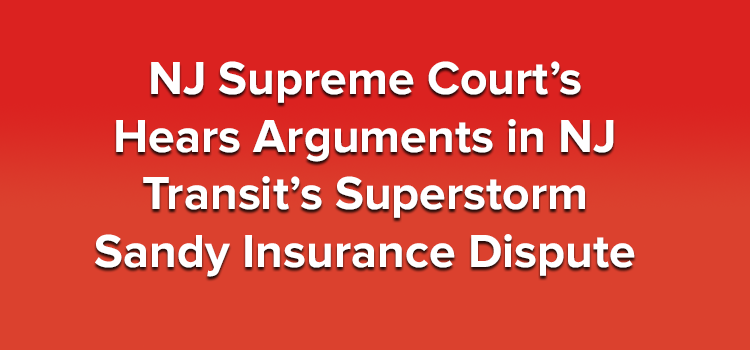
The Supreme Court of New Jersey recently heard oral arguments in a closely-watched case involving insurance claims related to Superstorm Sandy. The specific issue in New Jersey Transit Corporation v. Certain Underwriters at Lloyd’s London is whether New Jersey Transit Corporation’s (NJ Transit) insurers must insure $400 million of water damage loss caused by the storm.
Facts of NJ Transit Corp. v. Certain Underwriters at Lloyd’s London
In July 2012, NJ Transit, through its insurance broker, Marsh USA Inc. (Marsh), secured coverage from eleven insurers in a multi-layered property insurance policy program for the policy period from July 1, 2012, to July 1, 2013. The policies insured against “all risks” and provided coverage proportionally in four layers.
Lexington Insurance Company (Lexington) provided coverage in the primary layer and was responsible for the first $50 million of insurance. After the primary layer was exhausted, the policies provided three layers of excess coverage. The second layer provided coverage up to $100 million, and the third layer provided an additional $175 million. The fourth layer provided coverage of $125 million, resulting in a property insurance program with $400 million of coverage.
The defendants,Lloyd’s, London (Lloyd’s), Maiden Specialty Insurance Company (Maiden), RSUI Indemnity Company (RSUI), Specialty Insurance Company (Specialty), and Westport Insurance Corporation (Westport) (collectively, the “defendant insurers”), provided excess coverage in the third or fourth excess layers, or both. The policies of all participating insurers included a standard policy form and separate endorsements, some of which were included in all policies, and some which were unique to specific insurers.
On October 29, 2012, Superstorm Sandy struck New Jersey, causing significant damage to NJ Transit’s properties. After the storm, NJ Transit promptly notified Marsh and the insurers of its losses. NJ Transit’s employees, Marsh, and loss adjuster York Risk Services Group, Inc. (York) arranged for the inspection of the damaged properties and a valuation of the equipment that had to be repaired or replaced. Marsh then sought a determination as to the amount of coverage provided for the Sandy-related water damage to NJ Transit’s properties.
In April 2013, Terry S. Lubin, Executive General Adjuster for York, informed NJ Transit on behalf of the defendant insurers and other excess carriers that the claimed losses for water damage were limited by the $100 million flood sublimit in the policies, and the excess carriers would pay no more than $50 million in addition to the first-layer coverage provided by Lexington. NJ Transit disagreed, arguing that none of the sublimits in the policies applied to losses caused by a “named windstorm,” which was a separately defined peril.
In October 2014, NJ Transit filed suit, seeking a judgment declaring that the $100 million flood sublimit did not apply to its claims for property damage associated with Superstorm Sandy, and defendants were in anticipatory breach of their insurance contracts. In response, the defendant insurers maintained that they had no contractual obligation to provide coverage for any water-related damage caused by “flood” that exceeded $100 million, and asserted counterclaims for reformation of their policies.
The trial court found that the $100 million flood sublimit in the policies did not apply to NJ Transit’s claim, and it was entitled to coverage up to the full $400 million policy limits for the Sandy-related water damage. The trial court also found that defendant insurers had not submitted sufficient evidence to support their claims for reformation of the policies. Accordingly, the court granted summary judgment in favor of NJ Transit.
Appellate Division Decision in NJ Transit Corp. v. Certain Underwriters at Lloyd’s London
On appeal, the insurers argued that the water damage to NJ Transit’s properties were “losses caused by flood,” and therefore subject to the $100 million flood sublimit in the policies. The Appellate Division, however, affirmed the trial court’s decision. It concluded that the named windstorm provision controlled rather than the flood sublimit.
In reaching its decision, the appeals court cited the language of the insurance policies. As the Appellate Division explained:
The policies do not define “flood” to include “storm surge” and “wind driven water” associated with such a “named windstorm.” Although the definition of “flood” includes “surge,” the definition of “named windstorm” more specifically encompasses the wind driven water or storm surge associated with a “named windstorm.” Where, as here, two provisions of an insurance policy address the same subject, “the more specific provision controls over the more general.”
The Appellate Division further noted that if the parties had intended that damage from a “storm surge” would be subject to the flood sublimit, the policies would have stated so in plain language. “Moreover, if the term ‘flood’ already included damage from a ‘storm surge’ associated with a ‘named windstorm,’ as defendants claim, there would have been no need for the parties to include the ‘named windstorm’ provision in the policies,” the court added.
Issue before New Jersey Supreme Court
The New Jersey Supreme Court granted certification on June 18, 2020. The justices agreed to consider the following question:
Among other issues, were the losses suffered by the New Jersey Transit Corporation due to Superstorm Sandy covered up to the $400 million insurance limit in the policies, or only up to the $100 million flood sublimit in the policies?
The court held oral arguments on January 4, 2021. During their questioning of the insurers, several justices cited the policy’s plain language. In doing so, they questioned the meaning of the provisions, raising concern that the insurers’ arguments could make the windstorm provision redundant. A decision is expected in the coming months. Please check back for updates.
